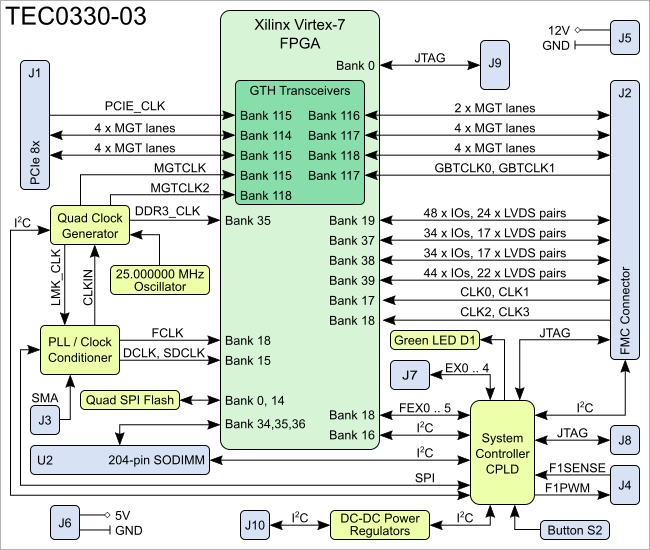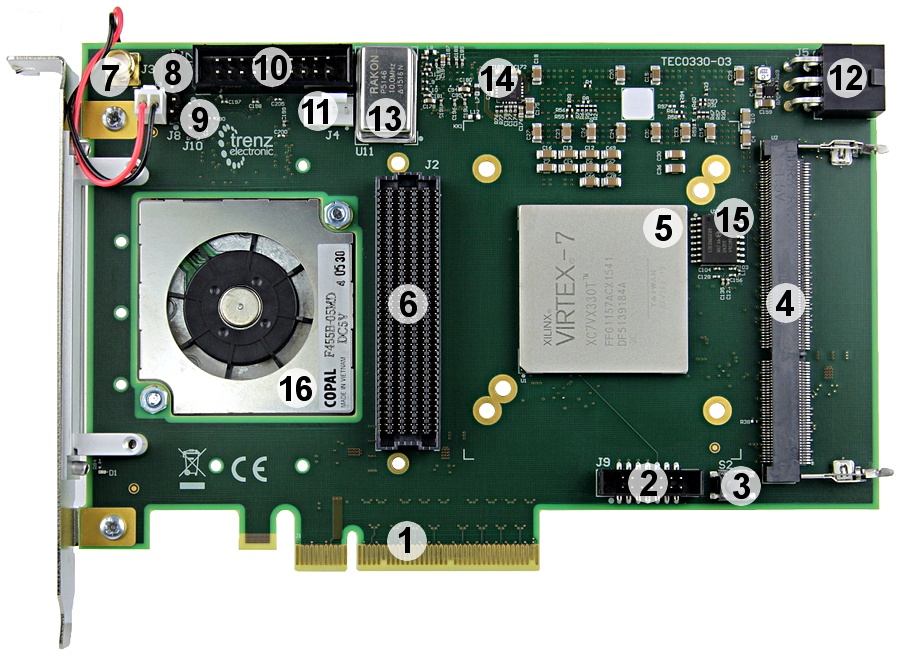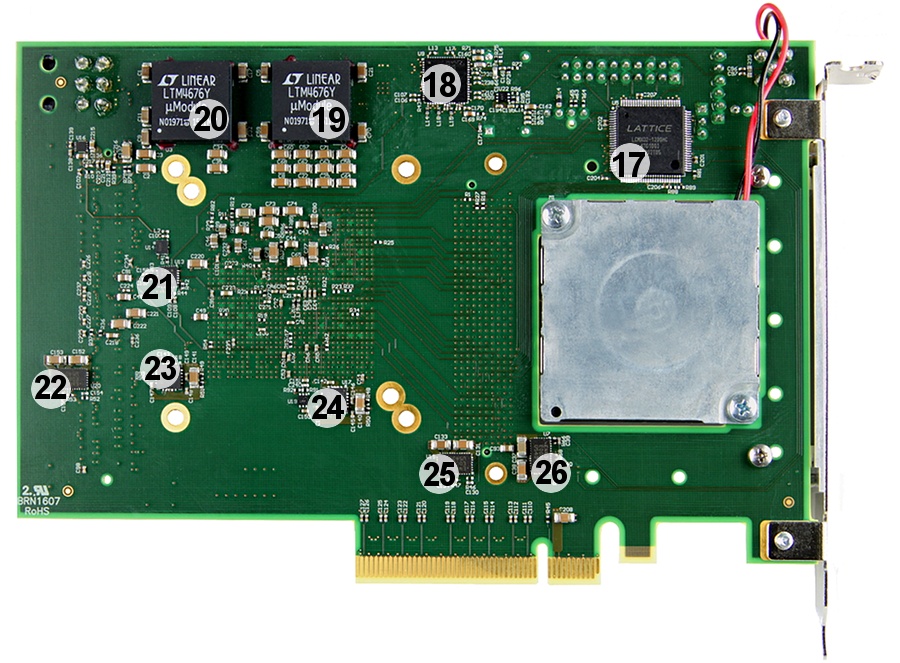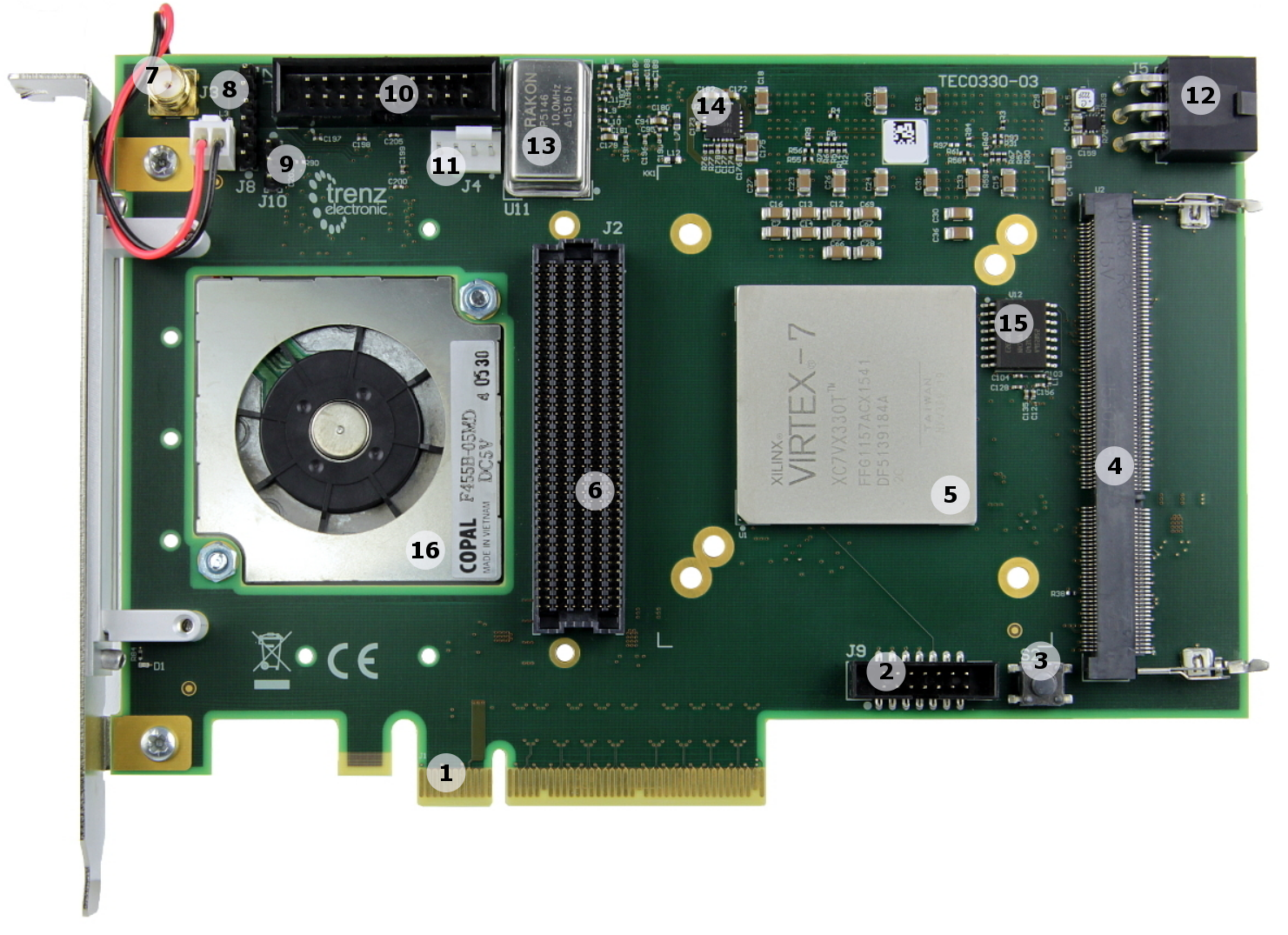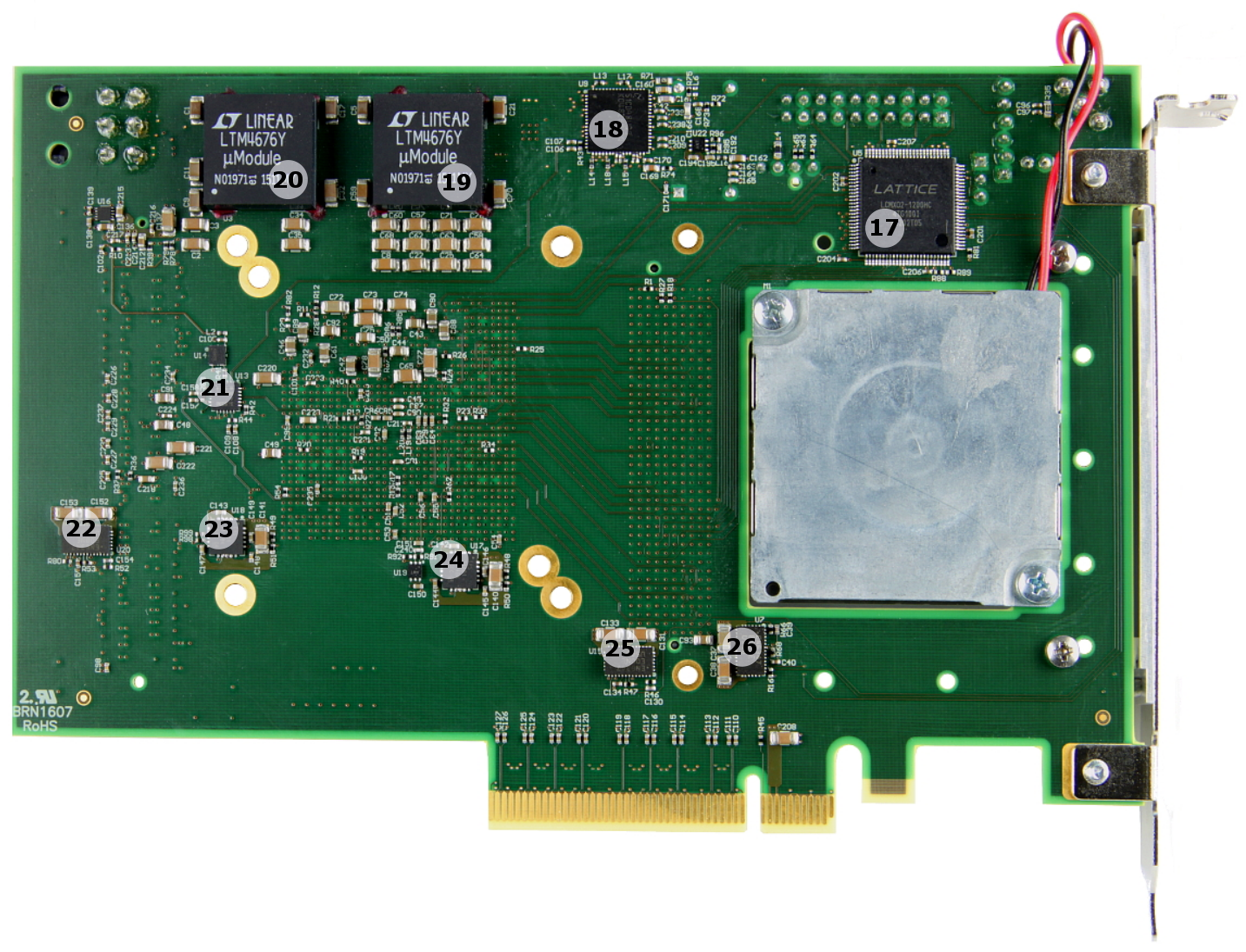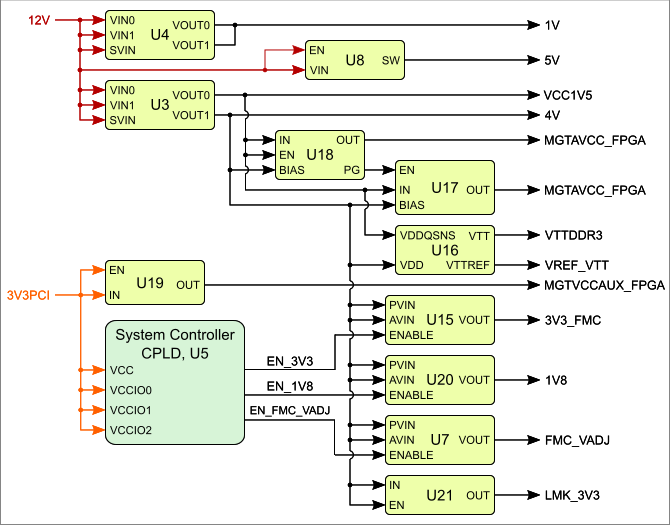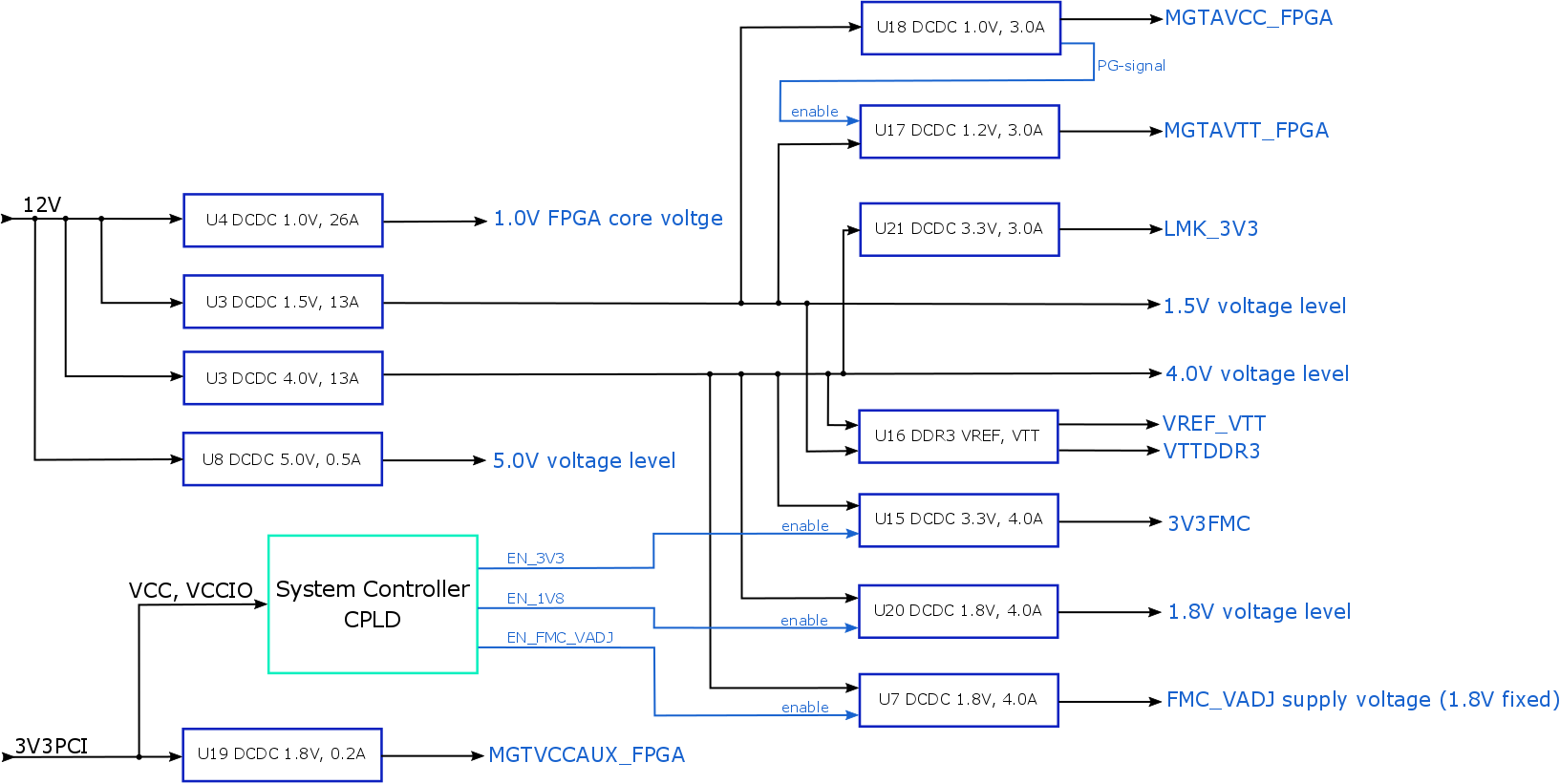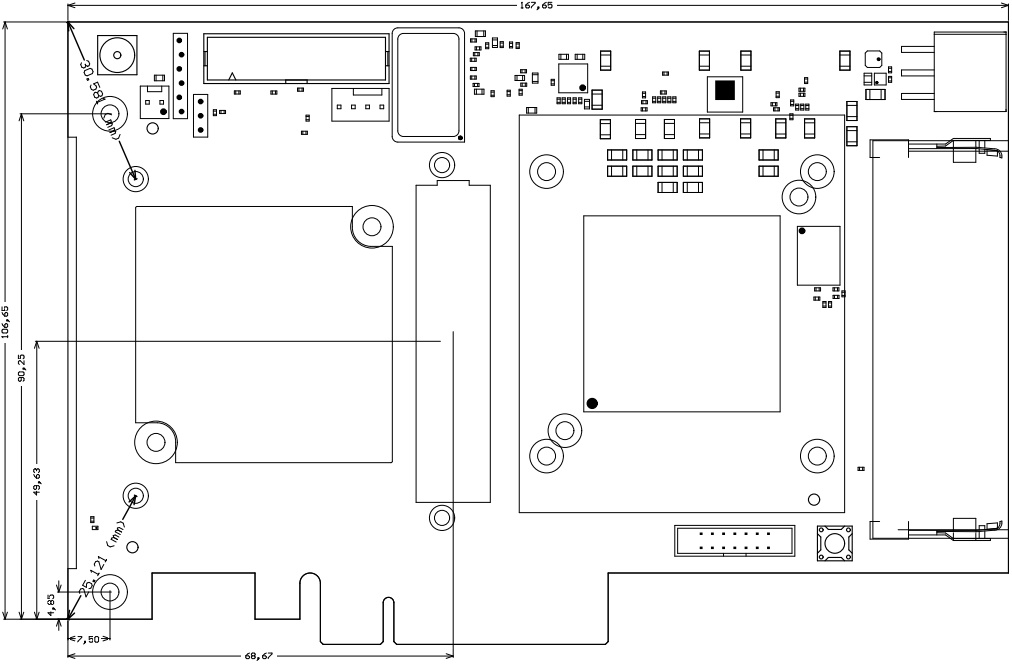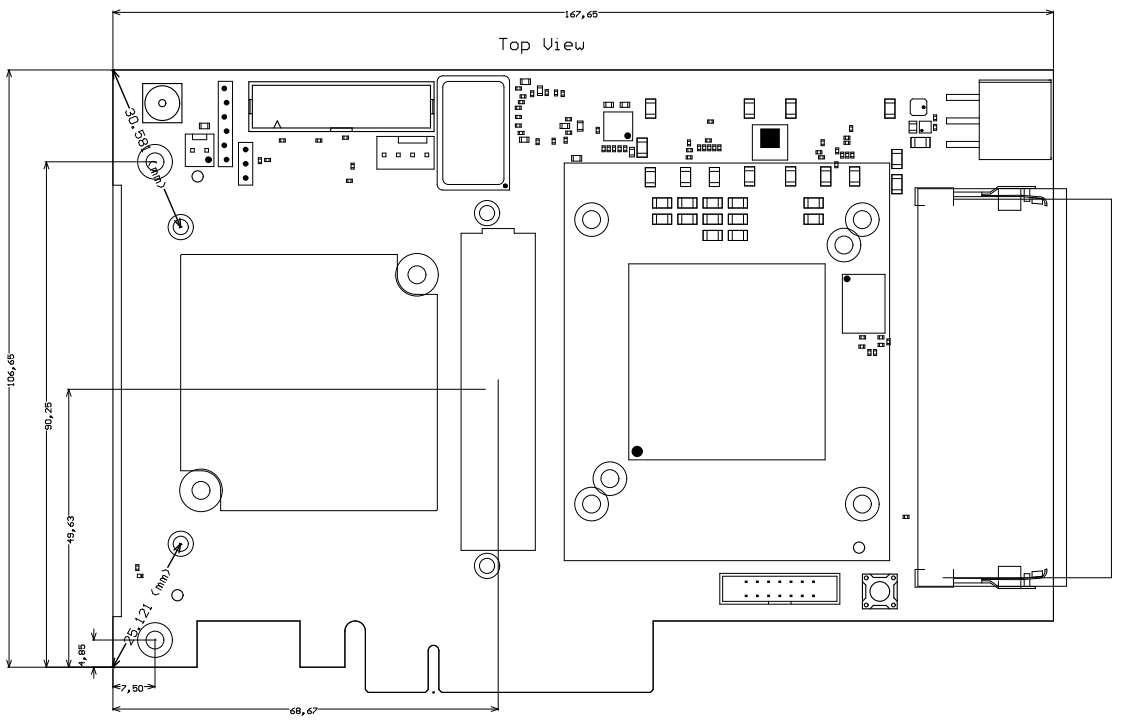Page History
| HTML |
|---|
<!--
Template Revision 1.63
(HTML comments will be not displayed in the document, no need to remove them. For Template/Skeleton changes, increase Template Revision number. So we can check faster, if the TRM style is up to date).
--> |
| Scroll Ignore |
|---|
Download PDF version of this document. |
| Scroll pdf ignore | |
|---|---|
Table of Contents
|
Overview
| Scroll Only (inline) |
|---|
Refer to https://shop.trenz-electronic.de/de/Download/?path=Trenz_Electronic/TEC0330/REV03 for downloadable version of this manual and additional technical documentation of the product. |
The Trenz Electronic TEC0330 FPGA board is a PCI Express form factor card (PCIe 2.0 or higher) integrating the Xilinx Virtex-7 XC7VX330T FPGA chip. This high-end FPGA card is designed for maximum system performance and intended for use in applications with high demands on system throughput. There is a SO-DIMM socket on the board for standard DDR3 SDRAM extension memory module.
The TEC0330 features HPC (High Pin Count) ANSI/VITA 57.1 compatible FMC interface connector for standard I/O Mezzanine modules. Other interface connectors found on-board include JTAG for accessing FPGA and on-board System Controller CPLD, and also connector with 5 high-speed I/O differential signaling pairs.
The TEC0330 FPGA board is intended to be used as add-on card in a PCIe 2.0 or higher capable host systems, it can not be used as a stand-alone device.
Key Features
- Xilinx Virtex-7 FPGA module XC7VX330T-2FFG1157C (commercial temperature range)
- PCI Express 2.0 x8 card with maximum throughput of 4 GB/s
- FMC High Pin Count (HPC) connector
- 8 FPGA MGT lanes available on PCIe interface
- DDR3 SO-DIMM SDRAM socket
- 256-Mbit (32-MByte) Quad SPI Flash memory (for configuration and operation) accessible through:
- FPGA
- JTAG port (SPI indirect, bus width x4)
- External clock input via SMA coaxial connector
- 28 GTH transceivers, each with up to 13.1 Gbit/s data transmission rate
- FPGA configuration through:
- JTAG connector
- Quad SPI Flash memory
- Programmable quad clock generator
- TI LMK04828B ultra low-noise JESD204B compliant clock jitter cleaner
- On-board high-efficiency DC-DC converters
- Up to 202 FPGA I/O pins available on FMC connector (up to 101 LVDS pairs possible)
- System management and power sequencing
- AES bit-stream encryption
- eFUSE bit-stream encryption
Additional assembly options are available for cost or performance optimization upon request.
Block Diagram
Figure 1: TEC0330-03 block diagram.
Main Components
Figure 2: FPGA board TEC0330-03.
- PCI Express 2.0 x8 connector, J1
- FPGA JTAG connector, J9
- User button, S2
- SO-DIMM socket, U2
- Xilinx Virtex-7 XC7VX330T-2FFG1157C FPGA, U1
- ANSI/VITA 57.1 compliant FMC HPC connector, J2
- SMA coaxial connector for external clock input, J3
- System Controller CPLD JTAG connector, J8
- I2C connector for LT LTM4676 step-down DC-DC regulator, J10
- IDC header for access to 5 x high-speed data lanes (LVDS pairs), J7
- 4-wire PWM fan connector, J4
- 6-pin 12V power connector, J5
- Reference clock generator @10.0 MHz (P5146) , U11
- LDO DC-DC regulator @3.3V (LMK_3V3) (TI TPS74901RGWR), U21
- 256 Mbit Quad SPI Flash Memory (Micron N25Q256A), U12
- Cooling fan 5VDC M1 (45X5MM, 0.7W, 1.06CFM)
- System Controller CPLD (Lattice Semiconductor LCMXO2-1200HC), U5
- Ultra low jitter clock synthesizer (TI LMK04828B), U9
- Step-down DC-DC regulator @1.0V (LT LTM4676), U4
- Step-down DC-DC regulator @1.5V (VCC1V5) (LT LTM4676, U3
- I2C Programmable quad clock generator (Silicon Labs Si5338A), U13
- 4A PowerSoC DC-DC converter @1.8V (Altera EN6347QI, U20
- LDO DC-DC regulator @1.0V (MGTAVCC_FPGA) (TI TPS74401RGW), U18
- LDO DC-DC regulator @1.2V (MGTAVTT_FPGA) (TI TPS74401RGW), U17
- 4A PowerSoC DC-DC converter @3.3V (3V3FMC) (Altera EN6347QI), U15
- 4A PowerSoC DC-DC converter @1.8V (FMC_VADJ) (Altera EN6347QI), U7
Initial Delivery State
| Storage device name | Content | Notes |
|---|---|---|
SPI Flash OTP Area | Empty, not programmed | Except serial number programmed by flash vendor. |
SPI Flash |
...
Download PDF version of this document.
| Scroll pdf ignore | |
|---|---|
Table of Contents
|
Overview
| Scroll Only (inline) |
|---|
Refer to https://shop.trenz-electronic.de/de/Download/?path=Trenz_Electronic/TEC0330/REV03 for downloadable version of this manual and additional technical documentation of the product. |
The Trenz Electronic TEC0330 FPGA board has a PCI Express card form factor and is containing the Xilinx FPGA-module Virtex-7 XC7VX330T. This high-end FPGA-module is optimized for system performance and is used in applications with high demands on system resources.
This board is designed to fit in computing systems with PCI Express x8 slots (PCIe 2.0 or higher) and has also a SO-DIMM socket to extend the board with DDR3-RAM.
The FMC (FPGA Mezzanine Card) connector provides a high pin count (HPC) and is as an ANSI/VITA 57.1 standard a modular interface to the FPGA for mezzanine expansion cards. Further connectors provide JTAG-interfaces to the FPGA-module and to the on-board System Controller CPLD together with access to high-speed data lanes composed of differential signaling pairs.
Block Diagram
Figure 1: TEC0330-03 Block Diagram
Main Components
Figure 2: FPGA board TEC0330-03
TEC0330-03:
- PCIe x8 connector J1
- FPGA JTAG connector J9
- User button S2
- SO-DIMM socket U2
- Xilinx Virtex-7 XC7VX330T-2FFG1157C FPGA-module U1
- ANSI/VITA 57.1 compliant FMC HPC Connector J2
- SMA coaxial connector for external clock input J3
- CPLD JTAG connector J8
- I²C-connector for LT LTM4676 Step-down DC/DC regulator J10
- IDC header for access to 5 x high-speed data lanes (LVDS-pairs) J7
- 4-Wire PWM fan connector J4
- 6-pin 12V power connector J5
- Reference clock generator (RAKON P5146, U11) @10.0 MHz
- LDO DC/DC regulator (TI TPS74901RGWR, U21) @3.3V (LMK_3V3)
- 256 Mbit Quad SPI Flash Memory (Micron N25Q256A, U12)
- Cooling fan 5VDC M1 (45X5MM, 0.7W, 1.06CFM)
- System Controller CPLD (Lattice Semiconductor MachXO2-1200HC, U5)
- Ultra low jitter clock synthesizer (TI LMK04828B, U9)
- Step-down DC/DC regulator (LT LTM4676, U4) @1.0V
- Step-down DC/DC regulator (LT LTM4676, U3) @1.5V (VCC1V5), @4.0V
- I²C Programmable Quad Clock Generator (Silicon Labs Si5338A, U13)
- 4A PowerSoC DC-DC converter (Altera EN6347QI, U20) @1.8V
- LDO DC/DC regulator (TI TPS74401RGW, U18) @1.0V (MGTAVCC_FPGA)
- LDO DC/DC regulator (TI TPS74401RGW, U17) @1.2V (MGTAVTT_FPGA)
- 4A PowerSoC DC-DC converter (Altera EN6347QI, U15) @3.3V (3V3FMC)
- 4A PowerSoC DC-DC converter (Altera EN6347QI, U7) @1.8V (FMC_VADJ)
Key Features
- Xilinx Virtex-7 FPGA module XC7VX330T-2FFG1157C (commercial temperature range)
- FPGA board designed as PCIe card is fitting in PCI Express x8 slots (PCIe 2.0 or higher)
- FMC High Pin Count (HPC) Connector
- 8 MGT-lanes available on PCIe interface
- DDR3 SO-DIMM Socket
- 256-Mbit (32-MByte) Quad SPI Flash memory (for configuration and operation) accessible through:
- FPGA
- JTAG port (SPI indirect (Bus width x4))
- External Clock Input via SMA coaxial connector
- 28 GTH transceivers, each with up to 13.1 Gbit/s data transmission rate
- FPGA configuration through:
- JTAG-connector
- SPI Flash memory
- Programmable quad PLL clock generator
- TI LMK04828B ultra low-noise high-performance clock synthesizer (jitter cleaner)
- On-board high-efficiency DC-DC converters
- Up to 202 FPGA I/O pins available on FMC connector (up to 101 LVDS-pairs possible)
- System management and power sequencing
- AES bit-stream encryption
- eFUSE bit-stream encryption
Additional assembly options are available for cost or performance optimization upon request.
Initial Delivery State
| Storage device name | Content | Notes |
|---|---|---|
SPI Flash OTP Area | Empty, not programmed | Except serial number programmed by flash vendor. |
SPI Flash Quad Enable bit | Programmed | - |
SPI Flash main array | Demo design | - |
eFUSE USER | Not programmed | - |
eFUSE Security | Not programmed | - |
Table 1: Initial delivery state.
Signals, Interfaces and Pins
FMC Connector
The high-pin count (HPC) FMC (FPGA Mezzanine Card) connector (J2) with high pin count (HPC) provides as an ANSI/is a standard ANSI/VITA 57.1 standard a modular interface to the FPGA and exposes numerous of its provides access to numerous FPGA I/O pins for use by other mezzanine modules and expansion cards. The FMC connector supports single ended I/O (with severeal several VCCIO voltages available) and differential signaling as the LVDS I/O 's are usable as LVDS-pairssignaling.
The I/O signals are routed from the FPGA I/O banks to the FMC connector as LVDS - pairs to the connector:
| FPGA Bank | I/O |
|---|
| Signals | LVDS |
|---|
| pairs |
|---|
| Bank Voltage (VCCO |
|---|
| ) | Notes | |||
|---|---|---|---|---|
| Bank 19 | 92 | 46 | 1.8V | - |
| Bank 39 | 42 | 21 | VIO_B_FMC |
Bank voltage VIO_B_FMC must be supplied by FMC connector pins J2-J39, J2-K40. |
Bank's |
VREF_B_M2C |
signal is routed to the FMC connector pin J2-K1 ( |
external reference voltage). | |||
| Bank 37 | 34 | 17 | 1.8V |
| Bank's VREF |
| _A_M2C |
| signal is routed to the FMC connector pin J2-H1 ( |
| external reference voltage). | |||
| Bank 38 | 34 | 17 | 1.8V |
| Bank's |
| VREF_A_M2C |
| signal is routed to the FMC connector pin J2-H1 ( |
| external reference voltage). |
Table 2: FMC connector pin-outs of available logic banks Overview of the FPGA .I/O bank signals routed to the FMC.
There are also The FMC connector provides also access to the MGT-banks of the FPGA. There are 10 high-speed data links MGT lanes (Xilinx GTH transceiver) available composed as differential signaling pairs for both directions (RX/TX), means from card to (mezzanine) module and vice versa.The MGT-banks have also clock input-pins which are exposed to the FMC connector. Following MGT-lanes are available transceivers) from different FPGA MGT banks routed to the FMC connector. Following MGT lanes are available on the FMC connector:
| FPGA Bank | I/O |
|---|
| Signals | LVDS |
|---|
| Pairs | MGT |
|---|
| Lanes | MGT Bank's Reference Clock | |||
|---|---|---|---|---|
| 116 | 8 | 4 | 2 | 1 clock-signal from clock synthesizer U9 to bank's pins T6/T5. |
| 117 |
| 16 |
| 8 |
| 4 | 2 clock-signals from clock FMC connector |
| GBTCLK0_M2C |
| and |
| GBTCLK1_M2C |
| (pins J2-D4/J2-D5 and J2-B20/J2-B21) to bank's pins M6/M5 and P6/P5 |
| . |
| 118 |
| 16 |
| 8 | 4 | 1 reference clock from clock synthesizer U9 to bank's pins F6/F5 1 reference clock from programmable quad |
clock generator U13 to bank's pins H6/H5 |
. |
Table 3: FMC connector pin-outs of available MGT-lanes of the FPGA
The FMC connector provides further interfaces like 'JTAG' and 'I²C' to the System Controller CPLD:
Overview of MGT banks lanes routed to the FMC connector.
The FMC connector has also two reference clock input pairs (LVDS) routed to the FPGA MGT bank 117, see also section MGT lanes.
| Page break |
|---|
There are also JTAG, I2C interface and power good control signals routed between FMC connector and System Controller CPLD:
| Interface | I/O Signals | Schematic Name / FMC Pin | Connected to |
|---|
| Notes | ||||
|---|---|---|---|---|
| JTAG | 5 | FMC_TRST, pin D34 FMC_TCK, pin D29 FMC_TMS, pin D33 FMC_TDI, pin D30 FMC_TDO, pin D31 | SC CPLD, bank 2 | VCCIO: 3V3PCI. |
| I2C | 2 | FMC_SCL, pin C30 FMC_SDA, pin C31 | SC CPLD, bank 2 | VCCIO: 3V3PCI. |
I2C-lines 3V3PCI pulled-up. |
| Control lines | 3 | FMC_PRSNT_M2C_L, pin H2 FMC_PG_C2M, pin D1 (3V3FMC pull-up) FMC_PG_M2C, pin F1 (3V3FMC pull-up) | SC CPLD, bank 1 |
PG |
- Power Good |
signal. |
C2M |
- carrier to |
mezzanine |
module. |
M2C |
- mezzanine |
module to carrier. |
Internal System Controller CPLD signal assignment: |
FEX_0_N |
<= |
FMC_PG_M2C |
FMC_PG_C2M |
<= |
FMC_PRSNT_M2C_L |
Table 4: FMC connector pin-outs of available interfaces to the System Controller CPLD
The FMC connector provides pins for reference clock input to the FPGA banks:
...
.
FPGA bank 17 and 18 clock inputs from FMC connector:
| Schematic Name | FMC Connector Pins | FPGA Bank | FPGA Pins |
|---|---|---|---|
| CLK0_P, CLK0_N | H4, H5 | 17 | R28, R29 |
| CLK1_P, CLK1_N | G2, G3 | 17 | P29, P30 |
| CLK2_P, CLK2_N | K4, K5 | 18 | G31, G31 |
| CLK3_P, CLK3_N | J2, J3 | 18 | H29, H30 |
Table 5: FMC connector pin-outs for reference clock input.
Several VCCIO voltages are available on the FMC connector to operate the for FPGA I/O 's in order of the intended purposebanks:
| Schematic Name | Max Current | FMC Connector Pins | VCCIO schematic name | max current | FMC connector pins | Notes |
|---|---|---|---|---|---|---|
| 12V | 1A | C35/, C37 | extern Externally supplied 12V | |||
| 3V3PCI | 20mA | D32 | supplied Supplied by the PCIe interface | |||
| 3V3FMC | 3A | D36/, D38/, D40/, C39 | supplied Supplied by DC/-DC converter U15 | |||
| VIO_B_FMC | extern External supply | J39/, K40 | extern Externally supplied VCCO to HB FPGA Bank bank 39 | |||
| FMC_VADJ | 4A | H40/, G39/, F40/, E39 | fixed Fixed to 1.8V, supplied by DC/-DC converter U7 |
Table 6: Available VCCIO voltages on FMC connector.
PCI Express Interface
The TEC0330 FPGA board is also a PCI Express card designed to fit in computing into systems with PCI Express x8 slots (PCIe 2.0 or higher) and is PCIe Gen. 2 capable. 8 MGT-lanes are See next section for the overview of FPGA MGT lanes routed to the PCIe interface composed of RX/TX LVDS-pairs for each lane:
...
.
MGT Lanes
MGT (Multi Gigabit Transceiver) lane consists of one receive and one transmit
...
(RX/TX
...
1 reference clock from programmable quad PLL clock generator
U13 to bank's pins AB6/AB5
1 reference clock from PCIe interface J1 to bank's pins AD6/AD5
...
Table 7: MGT-lanes available on PCIe interface
JTAG Interfaces
JTAG interfaces are accessible on the TEC0330 board to program the FPGA-module or the System Controller CPLD:
...
CPLD JTAG
VCCIO: 3V3PCI
Connector: J8
...
J8-4
...
FPGA JTAG
VCCIO: 1V8
Connector: J9
...
FMC JTAG
VCCIO: 3.3VPCI
Connector: J2
...
Table 8: JTAG Interface on TEC0330 board
SO-DIMM Socket for DDR3-RAM
The TEC0330 board can be upgraded with a DDR3 SO-DIMM (204-pin). For this purpose the board is equipped with a 204-pin SO-DIMM socket U2. The DDR3 memory interface is routed to the FPGA banks 34, 35 and 36.
The reference clock signal for the DDR3 interface is generated by the quad programmable reference clock U13 and is applied to bank 35.
There is also a I²C-interface between the System Controller CPLD and the DDR3 memory interface:
...
Table 9: I²C-interface between SC CPLD and DDR3 memory
System Controller CPLD
The System Controller CPLD is the central system management unit that provides numerous interfaces between the on-board peripherals and to the FPGA-module. The signals routed to the CPLD will be linked by the logic implemented in the CPLD firmware, which generates output signals to control the system, the on-board peripherals and the interfaces. So some interfaces between the on-board peripherals and to the FPGA-module are by-passed, forwarded and controlled by the System Controller CPLD.
Other tasks of the System Controller CPLD are the monitoring of the power-on sequence, the proper programing of the FPGA-module and to display its programming state.
...
Table 10: VCCIO voltages of CPLD banks
Following table describes the interfaces and functionalities established by the CPLD, which weren't discussed elsewhere in this TRM:
...
FPGA_IIC_SDA, pin 24
FPGA_IIC_SCL, pin 25
FPGA_IIC_OE, pin 19
...
FPGA bank 16, pin V29
FPGA bank 16, pin W29
FPGA bank 16, pin W26
...
VCCIO: 1V8
all lines 1V8 pulled-up
Following I²C-interfaces of are linked to the I²C-lines of 'FPGA_IIC' for data-transmission between the FPGA-module and on-board peripherals:
- FMC connector J2
- PCIe connector J1
- DC/DC converter U3 and U4 (LT LTM4676)
- Quad programmable PLL clock generator U13
Note: 'FPGA_IIC_OE' must kept high for I²C-operation.
For I²C-addresses refer to the data sheets of the components.
...
user I/O's
external LVDS-pairs
...
10 I/O's
5 x differential signaling pairs
...
EX0_P ... EX4_P
EX0_N ... EX4_N
...
pins can also be used for single-ended signaling
...
user I/O's
internal LVDS-pairs
...
13 I/O's
6 x differential signaling pairs
...
FEX0_P ... FEX5_P
FEX0_N ... FEX5_N
FEX_DIR (single-ended I/O)
...
VCCIO: 1V8
pins can also be used for single-ended signaling
FPGA bank 18 has also reference clock input from FMC connector (CLK2, CLK3) and from clock synthesizer U9 (FCLK)
internal signal assignment:
'FEX_DIR' <= 'FMC_PRSNT_M2C_L'
...
DONE, pin 7
PROGRAM_B, pin 8
...
FPGA bank 0, pin V8
FPGA bank 0, pin U8
...
PLL_SCL, pin 14
PLL_SDA, pin 15
...
U13, pin 12
U13, pin 19
...
VCCIO: 1V8
only 'PLL_SDA' 1V8 pulled-up
...
F1SENSE, pin 99
F1PWM, pin 98
...
J4-3 (low-active signal)
J4-4
...
internal signal assignment:
'FEX_5_P' <= 'F1SENSE'
'FEX_5_N' => 'F1PWM'
...
fast blinking, if FPGA not programmed
internal signal assignment:
'LED1' <= 'Button S2' or 'FEX0_P'
...
PCIe control line RESET_B
...
internal signal assignment:
'FEX_4_N' <= 'PCIE_RSTB'
...
Control Interface to clock synthesizer U9 (TI LMK04828B)
...
SPI (3 I/O's),
4 I/O's
...
CLK_SYNTH_SDIO, pin 75
CLK_SYNTH_SCK, pin 74
CLK_SYNTH_RESET, pin 54
CLK_SYNTH_CS, pin 53
CLK_SYNTH_SYNC, pin 52
LMK_STAT0, pin 62
LMK_STAT1, pin 63
...
U9, pin 20
U9, pin 19
U9, pin 5
U9, pin 18
U9, pin 6
U9, pin 31
U9, pin 48
...
'CLK_SYNTH_SDIO' 3V3PCI pulled-up
internal signal assignment:
'LMK_SCK' <= 'FEX_1_P'
'LMK_SDIO' <= 'FEX_1_N'
'LMK_CS' <= 'FEX_3_P'
'LMK_SYNC' <= 'FEX_3_N'
LMK_RESET <= 'FEX_4_P'
'FEX_2_P' => 'LMK_SDIO' (FEX_2_N must be 0)
'LMK_STAT0' and 'LMK_STAT1' signals will not be evaluated.
...
I²C (2 I/O's),
2 I/O's
...
LTM_SCL, pin 67
LTM_SDA, pin 66
LTM1_ALERT, pin 65
LTM2_ALERT, pin 64
...
U4, pin E6 and U3, pin E6
U4, pin D6 and U3, pin D6
U4, pin E5
U3, pin E5
...
all lines 3V3 pulled-up
LTM I²C-interface also accessible trough header J10
LTM1- and LTM2-Alert signals will not be evaluated.
...
EN_1V8, pin 58
PG_1V8, pin 59
EN_FMC_VADJ, pin 60
PG_FMC_VADJ, pin 61
EN_3V3, pin 51
PG_3V3, pin 57
...
U20, pin 27
U20, pin 28
U7, pin 27
U7, pin 28
U15, pin 27
U15, pin 28
...
The effective sequencing of the supply voltages depends on the currently programmed CPLD firmware.
EN_1V8, EN_3V3 and EN_FMC_VADJ will be set simultaneously at start-up.
PG-signals will not be evaluated.
) differential pairs, four signals total per one MGT lane. Following table lists lane number, MGT bank number, transceiver type, signal schematic name, FMC connector pin connection and FPGA pin connection information.
FPGA to FMC Connector MGT lanes
| Lane | FPGA Bank | Type | Signal Name | FPGA Pin | FMC Pin |
|---|---|---|---|---|---|
| 0 | 117 | GTH |
|
|
|
| 1 | 117 | GTH |
|
|
|
| 2 | 117 | GTH |
|
|
|
| 3 | 117 | GTH |
|
|
|
| 4 | 118 | GTH |
|
|
|
Table 8: FPGA to FMC connector MGT lanes overview (continue on next page).
| Page break |
|---|
FPGA to FMC Connector MGT lanes (continued)
| Lane | FPGA Bank | Type | Signal Name | FPGA Pin | FMC Pin |
|---|---|---|---|---|---|
| 5 | 118 | GTH |
|
|
|
| 6 | 118 | GTH |
|
|
|
| 7 | 118 | GTH |
|
|
|
| 8 | 116 | GTH |
|
|
|
| 9 | 116 | GTH |
|
|
|
Table 8: FPGA to FMC connector MGT lanes overview.
Page break
FPGA to PCIe Connector MGT lanes
| Lane | FPGA Bank | Type | Signal Name | FPGA Pin | PCIe Pin |
|---|---|---|---|---|---|
| 0 | 115 | GTH |
|
|
|
| 1 | 115 | GTH |
|
|
|
| 2 | 115 | GTH |
|
|
|
| 3 | 115 | GTH |
|
|
|
| 4 | 114 | GTH |
|
|
|
| 5 | 114 | GTH |
|
|
|
| 6 | 114 | GTH |
|
|
|
| 7 | 114 | GTH |
|
|
|
Table 9: FPGA to PCIe connector MGT lanes overview.
| Page break |
|---|
Following table lists reference clock sources of the MGT banks.
| Clock Signal | MGT Bank | Source | FPGA Pin | Notes |
|---|---|---|---|---|
| MGTCLK_5338_P | 115 | U13, CLK1A | MGTREFCLK0P_115, AB6 | On-board Si5338A. |
| MGTCLK_5338_N | 115 | U13, CLK1B | MGTREFCLK0N_115, AB5 | On-board Si5338A. |
| PCIE_CLK_P | 115 | J1-A13, REFCLK+ | MGTREFCLK1P_115, AD6 | External clock from PCIe slot. |
| PCIE_CLK_N | 115 | J1-A14, REFCLK- | MGTREFCLK1N_115, AD6 | External clock from PCIe slot. |
| CLK_SYNTH_DCLKOUT4_P | 116 | U9, DCLKout4 | MGTREFCLK0P_116, T6 | On-board LMK04828B. |
| CLK_SYNTH_DCLKOUT4_N | 116 | U9, DCLKout4* | MGTREFCLK0N_116, T6 | On-board LMK04828B. |
| GBTCLK0_M2C_P | 117 | J2-D4 | MGTREFCLK0P_117, M6 | External clock from FMC connector. |
| GBTCLK0_M2C_N | 117 | J2-D5 | MGTREFCLK0N_117, M5 | External clock from FMC connector. |
| GBTCLK1_M2C_P | 117 | J2-B20 | MGTREFCLK1P_117, P6 | External clock from FMC connector. |
| GBTCLK1_M2C_N | 117 | J2-B21 | MGTREFCLK1N_117, P5 | External clock from FMC connector. |
| CLK_SYNTH_SDCLKOUT7_P | 118 | U9, DCLKout7 | MGTREFCLK0P_118,F6 | On-board LMK04828B. |
| CLK_SYNTH_SDCLKOUT7_N | 118 | U9, DCLKout7* | MGTREFCLK0N_118,F5 | On-board LMK04828B. |
| MGTCLK2_5338_P | 118 | U13, CLK3A | MGTREFCLK1P_118, H6 | On-board Si5338A. |
| MGTCLK2_5338_N | 118 | U13, CLK3B | MGTREFCLK1N_118, H5 | On-board Si5338A. |
Table 10: MGT banks reference clock sources.
| Page break |
|---|
JTAG Interfaces
There are three JTAG interfaces available on the TEC0330 board:
| JTAG Interface | Signal Schematic Name | JTAG Connector Pin | Connected to |
|---|---|---|---|
CPLD JTAG VCCIO: 3V3PCI Connector: J8 | CPLD_JTAG_TMS | J8-1 | SC CPLD, bank 0, pin 90 |
| CPLD_JTAG_TDI | J8-2 | SC CPLD, bank 0, pin 94 | |
| CPLD_JTAG_TDO | J8-3 | SC CPLD, bank 0, pin 95 | |
| CPLD_JTAG_TCK | J8-4 | SC CPLD, bank 0, pin 91 | |
FPGA JTAG VCCIO: 1V8 Connector: J9 | FPGA_JTAG_TMS | J9-4 | FPGA, bank 0, pin N9 |
| FPGA_JTAG_TMS | J9-6 | FPGA, bank 0, pin M8 | |
| FPGA_JTAG_TCK | J9-8 | FPGA, bank 0, pin N8 | |
| FPGA_JTAG_TDI | J9-10 | FPGA, bank 0, pin L8 | |
FMC JTAG VCCIO: 3.3VPCI Connector: J2 | FMC_TRST | J2-D34 | SC CPLD, bank 2, pin 36 |
| FMC_TRST | J2-D29 | SC CPLD, bank 2, pin 27 | |
| FMC_TCK | J2-D33 | SC CPLD, bank 2, pin 28 | |
| FMC_TMS | J2-D30 | SC CPLD, bank 2, pin 31 | |
| FMC_TDO | J2-D31 | SC CPLD, bank 2, pin 32 |
Table 11: JTAG interfaces on TEC0330 board.
On-board Peripherals
System Controller CPLD
The System Controller CPLD is the central system management unit that provides numerous interfaces between the on-board peripherals and to the FPGA module. The signals routed to the CPLD will be linked by the logic implemented in the CPLD firmware, which generates output signals to control the system, the on-board peripherals and the interfaces. So some interfaces between the on-board peripherals and to the FPGA module are by-passed, forwarded and controlled by the System Controller CPLD.
Other tasks of the System Controller CPLD are the monitoring of the power-on sequence, the proper programing of the FPGA module and to display its programming state.
| SC CPLD Bank | CPLD Bank's VCCIO |
|---|---|
| 0 | 3V3PCI |
| 1 | 3V3PCI |
| 2 | 3V3PCI |
| 3 | 1V8 |
Table 12: VCCIO voltages of CPLD banks.
Following table describes the interfaces and functionalities of the System Controller CPLD not described elsewhere in this TRM:
| CPLD Functionality | Interface | Designated CPLD Pins | Connected to | Notes |
|---|---|---|---|---|
| I2C interface between on-board peripherals and FPGA | I2C |
|
| VCCIO: 1V8, all with pull-up to 1V8. Following devices and connectors are linked to the FPGA_IIC I2C interface:
Note: FPGA_IIC_OE must kept high for I2C operation. For I2C slave device addresses refer to the component datasheets. |
User I/Os External LVDS pairs | 10 I/Os 5 x LVDS pairs |
|
| Can also be used for single-ended signaling. |
User I/Os Internal LVDS pairs | 13 I/Os 6 x LVDS pairs |
|
| VCCIO: 1V8 Can also be used for single-ended signaling. FPGA bank 18 has also reference clock input from FMC connector (CLK2, CLK3) and clock synthesizer U9 (FCLK). Internal signal assignment: FEX_DIR <= FMC_PRSNT_M2C_L |
| FPGA programming control and state | 2 I/Os |
|
| VCCIO: 1V8 |
| I2C interface to programmable quad clock generator | I2C |
|
| VCCIO: 1V8 Only PLL_SDA has 1V8 pull-up. |
| Fan PWM control J4 | 2 I/Os |
|
| Internal signal assignment:
|
| Button S2 | 1 I/O |
|
| Functionality depends on CPLD firmware, activating pin PROGRAM_B (active low) and LED1 in standard configuration. |
| LED1 | 1 I/O |
|
| Fast blinking, when FPGA is not programmed. Internal signal assignment:
|
PCIe control line RESET_B | 1 I/O |
|
| Internal signal assignment:
|
Control interface to clock synthesizer U9 (TI LMK04828B) | SPI (3 I/Os), 4 I/Os |
|
| Pull up to 3V3PCI.
|
| Control Interface to DC-DC converters U3 and U4 (both LTM4676) | I2C (2 I/Os), 2 I/Os |
|
| 3V3 pull-ups. LTM I2C interface is also accessible trough header J10. LTM1_ALERT and LTM2_ALERT signals are not used. |
| Power-on sequence and monitoring | 6 I/Os |
|
| Sequence of the supply voltages depend on the System Controller CPLD firmware. EN_1V8, EN_3V3 and EN_FMC_VADJ will be set simultaneously at start-up. PG signals will not be evaluated. |
Table 13: Overview of the System Controller CPLD functions.
SO-DIMM Socket for DDR3 SDRAM
The TEC0330 board supports additional DDR3 SO-DIMM via 204-pin socket U2. The DDR3 memory interface is routed to the FPGA banks 34, 35 and 36.
The reference clock signal for the DDR3 interface is generated by the quad programmable clock generator U13 and is applied to the FPGA bank 35.
There is also a I2C interface between the System Controller CPLD and the DDR3 SDRAM memory:
| Interface Signals Schematic Name | System Controller CPLD Pin | DDR3 Memory Interface Pin |
|---|---|---|
| DDR3_SDA | Bank 2, pin 48 | Pin 200 (3V3PCI pull-up) |
| DDR3_SCL | Bank 2, pin 49 | Pin 202 (3V3PCI pull-up) |
Table 14: I2C-interface between SC CPLD and DDR3 SDRAM memory.
Quad SPI Flash Memory
An 256 Mbit (32 MByte) Quad SPI Flash Memory (Micron N25Q256A, U12) is provided for FPGA configuration file storage. After configuration process completes the remaining free memory can be used for application data storage. All four SPI data lines are connected to the FPGA allowing x1, x2 or x4 data bus widths to be used. The maximum data transfer rate depends on the bus width and clock frequency. The memory can be accessed indirectly by the FPGA JTAG port (J9) by implementing the functional logic for this purpose inside the FPGA.
Clock sources
Table 11: System Controller CPLD functionalities
Clocking
The TEC0330 FPGA board has a sophisticated clock generation and conditioning system to meet the requirements of the Xilinx Virtex-7 GTH units with data transmission rates up to 13.1 Gb/s.
Clock sources
The board has the following sources to be provided with extern reference clock signals and on-board clock oscillators:
.
List of on-board and external reference clock signals of the TE0330 board:
| Clock Sourceclock generator sources | Schematic Name | Frequency | clock input destination | NotesClock Destination |
|---|---|---|---|---|
| SMA coaxial connector, J3 | CLK_SYNTH_CLKIN0_P, CLK_SYNTH_CLKIN0_N (GND) | userUser | clock Clock synthesizer U9, pins 37/38 | -|
| RAKON P5146LF oscillator, U11 | - | 10.0 MHz | clock Clock synthesizer U9, pins 43/44- | |
| SiTime SiT8208 oscillator, U14 | CLK_25MHz | 25.0 MHz | Programmable quad PLL clock Generator generator U13, pin 3 | - |
| FMC connector J2, pins H4/H5 | CLK0_P, CLK0_N | userUser | FPGA bank 17, pins R28/R29- | |
| FMC connector J2, pins G2/G3 | CLK1_P, CLK1_N | userUser | FPGA bank 17, pins P29/P30 | - |
| FMC connector J2, pins K4/K5 | CLK2_P, CLK2_N | userUser | FPGA bank 18, pins G30/G31- | |
| FMC connector J2, pins J2/J3 | CLK3_P, CLK3_N | userUser | FPGA bank 18, pins H29/H30- | |
| FMC connector J2, pins D4/D5 | GBTCLK0_M2C_P, GBTCLK0_M2C_N | userUser | FPGA bank 117, pins M6/M5 | - |
| FMC connector J2, pins B20/B21 | GBTCLK1_M2C_P, GBTCLK1_M2C_N | userUser | FPGA bank 117, pins P6/P5- | |
| PCIe interface J1, pins A13/A14 | PCIE_CLK_P, PCIE_CLK_N | 100 MHz (PCIe spec.) | FPGA bank 115, pins AD6/AD5- |
Table 1215: Clock generator sources overviewoverview.
| Page break |
|---|
Programmable
...
Clock Generator
There is a Silicon Labs I²C I2C programmable quad PLL clock generator Si5338A (U13) on-board. It's output frequencies can be programmed by using the I²C-bus with address 0x70.
A 25 MHz (U14) oscillator is connected to pin 3 (IN3) and is used to generate the output clocks.
are programmable via FPGA I2C interface using slave device address 0x70 (corresponding I2C logic has to be implemented in FPGA design).
A 25 MHz (U14) oscillator is connected to pin 3 (IN3) and is used to generate the output clocksOnce running, the frequency and other parameters can be changed by programming the device using the I²C-bus connected between the FPGA (master) and clock generator (slave). Logic needs to be generated inside the FPGA-module to utilize I²C-bus correctly.
| Si5338A (U13) input | signal schematic name | Input | Signal Schematic Name | NotesNote |
|---|---|---|---|---|
IN1/IN2 | CLKIN_5338_C_P, CLKIN_5338_C_N | reference Reference clock signal from clock synthesizer U9 (100 nF decoupling capacitors and 100Ω termination resistor). | ||
IN3 | clock signal from reference Reference clock oscillator input, SiTime SiT8208AI (U14). | 25.0 MHz fixed frequency. | ||
IN4/IN6 | pins put Connected to the GND. | LSB (pin 'IN4') of the default I²C-adress 0x70 is zero. | ||
IN5 | not Not connected | - | ||
| Si5338A (U13) output | signal schematic name | Output | Signal Schematic Name | NotesNote |
CLK0 A/B | DDR3_CLK_P, DDR3_CLK_N | DDR3-RAM reference clock signal to FPGA bank 35. | ||
CLK1 A/B | MGTCLK_5338_C_P, MGTCLK_5338_C_N | reference Reference clock signal to FPGA bank 115 MGT (100 nF decoupling capacitors and 100Ω termination resistor). | ||
CLK2 A/B | LMK_CLK_P, LMK_CLK_N | input Input clock signal to clock synthesizer U9 (100 nF decoupling capacitors). | ||
| CLK3 A/B | MGTCLK2_5338_C_P, MGTCLK2_5338_C_N | reference Reference clock signal to FPGA bank 118 MGT (100 nF decoupling capacitors and 100Ω termination resistor). |
Table 13: Pin 16: I/O pin description of PLL programmable clock generator Si5338A.
| Page break |
|---|
Ultra low-noise high-performance clock synthesizer
The TEC0330 board utilizes an ultra low jitter clock synthesizer TI LMK04828B (U9) for conditioning and generating clean clock signals which are necessary for the GTH units of the Xilinx Virtex-7 FPGA - module.
The clock synthesizer can be controlled and programmed by its SPI - interface (SPI - slave) and other control lines, which are routed to the FPGA - module (SPI - master) and by-passed trough the System Controller CPLD. See section 'System Controller CPLD' for more detailed information.
Logic needs to be generated inside the FPGA - module to utilize SPI - bus correctly.
| LMK04828B (U9) input | signal schematic name | Note |
|---|---|---|
| Status_LD1, Status_LD2 | LMK_STAT0, LMK_STAT1 |
| Connected to System Controller CPLD, not |
| implemented in current CPLD |
| firmware. |
SPI |
interface and control lines | see section 'System controller CPLD' |
| The clock synthesizer |
| IC is accessible to the FPGA |
| via the SPI |
| interface and control lines, which are |
| routed through the System Controller CPLD. | |
| CLKin0, CLKin0* | CLK_SYNTH_CLKIN0_P, CLK_SYNTH_CLKIN0_N |
Input reference clock signal via SMA coaxial connector J3, connected to CLKin0* via serial decoupling |
capacitor 100nF. CLKin0 to connected to GND via serial decoupling |
capacitor 100nF. | |
| CLKin1, CLKin1* | CLK_SYNTH_CLKIN1_P, CLK_SYNTH_CLKIN1_N |
| Input reference clock signal from programmable quad |
| clock generator Si5338A (U13) via serial decoupling |
| capacitor 100nF. | |
| OSCin, OSCin* | - |
| Signal from reference clock oscillator RAKON P51446LF, fixed to 10.0 MHz. | ||
| LMK04828B (U9) output | signal schematic name | Note |
|---|---|---|
| DCLKout0, DCLKout0* | CLK_SYNTH_DCLKOUT0_P, CLK_SYNTH_DCLKOUT0_N |
| Reference clock signal to FPGA bank 15 pins AD29/AE29. | |
| SDCLKout1, SDCLKout1* | CLK_SYNTH_SDCLKOUT1_P, CLK_SYNTH_SDCLKOUT1_N |
| Reference clock signal to FPGA bank 15 pins AE31/AF31. | |
| DCLKout2, DCLKout2* | CLKIN_5338_P, CLKIN_5338_N |
Reference clock signal to programmable quad |
clock generator Si5338A (U13) |
(100 nF decoupling capacitors and 100Ω termination resistor). | |
| DCLKout4, DCLKout4* | CLK_SYNTH_DCLKOUT4_P, CLK_SYNTH_DCLKOUT4_N |
| Reference clock signal to FPGA MGT bank 115 |
| , pins T6/T5. | |
| SDCLKout7, SDCLKout7* | CLK_SYNTH_SDCLKOUT7_P, CLK_SYNTH_SDCLKOUT7_N |
| Reference clock signal to FPGA MGT bank 118 |
| , pins F6/F5. | |
| OSCout0, OSCout0* | CLK_SYNTH_CLKIN2_P, CLK_SYNTH_CLKIN2_N |
Reference clock signal to FPGA bank 18, pins J30/J31 |
(100 nF decoupling capacitors). |
Table 1417: Pin description of clock synthesizer TI LMK04828B
32 MByte Quad SPI Flash Memory
An 256 Mbit (32 MByte) Quad SPI Flash Memory (Micron N25Q256A, U12) is provided for FPGA configuration file storage. After configuration process completes the remaining free memory can be used for application data storage. All four SPI data lines are connected to the FPGA allowing x1, x2 or x4 data bus widths to be used. The maximum data transfer rate depends on the bus width and clock frequency. The memory can be accessed indirectly by the FPGA JTAG-port (J9) by implementing the functional logic for this purpose inside the FPGA.
Power and Power-On Sequence
Power Supply
The TEC0330 FPGA board is mainly suppled by the 6-pin 12V power connector J5, a minimum current capability of 3A for system startup is recommended. The FPGA board can't be used as a stand-alone board, it works only in use of a plugged PCI Express card (2.0 or higher).
Power Consumption
...
.
Power and Power-On Sequence
Power Supply
6-pin 12V power connector J5 is the main power supply of the TEC0330 FPGA board, minimum current capability of 3A for system startup is recommended.
Power Consumption
| Power Input | Typical Current |
|---|---|
| 12V (J5) | TBD |
| 3V3PCI (J1) | TBD |
Table 18: Typical power consumption.
TBD - To Be Determined.
| Page break |
|---|
Power-On Sequence
The on-board voltages of the TEC0330 FPGA board are powered up in predefined sequence after the external voltages 12V on connector J5 and 3V3PCI on connector J1 become available.
Core voltages and main supply voltages have to reach stable state and their "Power Good" signals have to be asserted before other voltages like PL bank's I/O voltages can be powered up.
Following diagram describes the sequence of enabling the on-board voltages:
Figure 3: FPGA board TEC0330-03 power-on sequence diagram.
Bank Voltages
| Bank | Schematic Name | Voltage | Range | Notes |
|---|---|---|---|---|
| 0 | 1V8 | 1.8V | HP: 1.2V to 1.8V | Config bank (fixed to 1.8V) / JTAG interface. |
| 14 | 1V8 | 1.8V | HP: 1.2V to 1.8V | QSPI flash memory interface. |
| 15 | 1V8 | 1.8V | HP: 1.2V to 1.8V | Reference clock input. |
| 16 | 1V8 | 1.8V | HP: 1.2V to 1.8V | I2C interface of FPGA. |
| 17 | 1V8 | 1.8V | HP: 1.2V to 1.8V | Reference clock input. |
| 18 | 1V8 | 1.8V | HP: 1.2V to 1.8V | Reference clock input / I/O's to CPLD. |
| 34 | VCC1V5 | 1.5V | HP: 1.2V to 1.8V | DDR3 memory interface. |
| 35 | VCC1V5 | 1.5V |
Table 15: Maximum current of power supplies. *to be determined
Power-On Sequence
The on-board voltages of the TEC0330 FPGA board will be powered-up in order of a determined sequence after the external voltages '12V' on connector J5 and '3V3PCI' on connector J1 are available.
Core voltages and main supply voltages have to reach stable state and their "Power Good"-signals have to be asserted before other voltages like PL bank's I/O voltages can be powered up.
Following diagram clarifies the sequence of enabling the particular on-board voltages:
Figure 3: FPGA board TEC0330-03 Power-On sequence diagram
Bank Voltages
| Bank | Schematic Name | Voltage | Range | Note | |||
|---|---|---|---|---|---|---|---|
| 0 | 1V8 | 1.8VHP: 1.2V to 1.8V | DDR3 memory interface. | ||||
| 36 | VCC1V5 | 1.5V | HP: 1.2V config bank (fixed to 1.8V) / JTAG interface | 14 | 1V8DDR3 memory interface. | ||
114 115 116 117 118 | MGTAVCC_FPGA MGTVCCAUX_FPGA MGTAVTT_FPGA | 1.0V 1.8V HP:1.2V to 1.8V | MGT bank supply voltage MGT bank auxiliary supply voltage MGT bank termination circuits voltage | MGT banks with Xilinx GTH transceiver units. | |||
| 19 | QSPI flash memory interface | 15 | 1V8 | 1.8V | HP: 1.2V to 1.8V | I/Os routed to FMC, usable as LVDS pairs. | |
| 37 | reference clock input | 16 | 1V8 | 1.8V | HP: 1.2V to 1.8V | I²C interface of FPGA | |
| 17 | 1V8 | 1.8V | HP: 1.2V to 1.8V | reference clock input | |||
| I/Os routed to FMC, usable as LVDS pairs. | |||||||
| 38 | 18 | 1V8 | 1.8V | HP: 1.2V to 1.8V | reference clock input / I/O's to CPLDOs routed to FMC, usable as LVDS pairs. | ||
| 39 | VIO_B_FMC | user | 34 | VCC1V5 | 1.5V | HP: 1.2V to 1.8V | DDR3 memory interface |
| 35 | VCC1V5 | 1.5V | HP: 1.2V to 1.8V | DDR3 memory interface | |||
| 36 | VCC1V5 | 1.5V | HP: 1.2V to 1.8V | DDR3 memory interface | |||
114 115 116 117 118 | MGTAVCC_FPGA MGTVCCAUX_FPGA MGTAVTT_FPGA | 1.0V 1.8V 1.2V | MGT bank supply voltage MGT bank auxiallary supply voltage MGT bank termination circuits voltage | MGT banks with Xilinx GTH transceiver units | |||
| 19 | 1V8 | 1.8V | HP: 1.2V to 1.8V | bank's I/O's exposed to FMC, usable as LVDS-pairs | |||
| 37 | 1V8 | 1.8V | HP: 1.2V to 1.8V | bank's I/O's exposed to FMC, usable as LVDS-pairs | |||
| 38 | 1V8 | 1.8V | HP: 1.2V to 1.8V | bank's I/O's exposed to FMC, usable as LVDS-pairs | |||
| I/Os routed to FMC, usable as LVDS pairs. |
Table 19: Range of FPGAs bank voltages.
See Xilinx Virtex-7 datasheet (DS183) for the voltage ranges allowed.
| Page break |
|---|
Power Rails
| Connector / Pin | Voltage | Direction | Notes | |
|---|---|---|---|---|
| J4, pin 2 | 12V (filtered) | Output | 4-wire PWM fan connector supply voltage | |
| J6, pin 2 | 5V (filtered) | Output | Cooling fan M1 supply voltage | |
| J8, pin 6 | 3V3PCI | Output | VCCIO CPLD JTAG | |
| J9, pin 2 | 1V8 | Output | VCCIO FPGA JTAG | |
| J2, pin C35 / C37 | 12V | Output | VCCIO FMC | |
| J2, pin D32 | 3V3PCI | Output | VCCIO FMC | |
| J2, pin D36 / D38 / D39 / D40 | 3V3FMC | Output | VCCIO FMC | |
| J2, pin H1 | VREF_A_M2C | Input | VREF voltage for bank 37 / 38 | |
| J2, pin K1 | VREF_B_M2C | Input | VREF voltage for bank 39 | |
| J2, pin J39 / J40 39 | VIO_B_FMC | user | HP: 1.2V to 1.8V | bank's I/O's exposed to FMC, usable as LVDS-pairs |
Table 16: Range of FPGAs bank voltages
See Xilinx Virtex-7 datasheet (DS183) for the voltage ranges allowed.
Power Rails
...
| Input | PL I/O voltage bank 39 (VCCO) | ||
| J2, pin H40 / G39 / F40 / E39 | FMC_VADJ | Output | VCCIO FMC (fixed to 1.8V) |
| J1, pin A10 / A11 / B8 | 3V3PCI | Input | PCIe interface supply voltage |
| J5, pin 1 / 2 / 3 | 12V | Input | Main power supply connector |
Table 20: Power rails and corresponding connectors of the FPGA board.
Technical Specifications
Absolute Maximum Ratings
| Parameter | Min | Max | Units | Notes | Notes |
|---|---|---|---|---|---|
12V power supply voltage | 11.4 | 12.6 | V | 12V ± 5 % | ANSI/VITA 57.1 FPGA Mezzanine Card (FMC) standard |
| PL I/O voltage for HP banks | -0.55 | VCCO_X + 0.55 | V | - | Xilinx datasheet DS183 |
| GTH transceivers | -0.5 | 1.26 | V | - | Xilinx datasheet DS183 |
| Voltage on System Controller CPLD pins | -0.3 | 3.6 | V | - | MachXO2 family datasheet |
| Storage temperature | -55 | +125 | °C | - | MachXO2 family datasheet |
Table 21: Absolute maximum ratings.
Recommended Operating Conditions
Table 17: Power rails of FPGA board on accessible connectors
Technical Specifications
...
| Parameter | Min | Max | Units | Notes |
|---|
| Reference Document | |||||
|---|---|---|---|---|---|
| 12V power supply voltage | 11.4 | 12.6 | V | 12V ± 5 % | ANSI/VITA 57.1 FPGA |
| Mezzanine Card (FMC) |
| standard | |
| PL I/O voltage for HP banks | -0. |
| 2 |
| VCCO_X + 0. |
| 2 | V | - | Xilinx datasheet DS183 |
| GTH |
| transceivers | (*) | (*) | - | - | Xilinx datasheet DS183 |
| Voltage on System |
| Controller CPLD pins |
| 3. |
| 135 | 3.6 | V | - |
MachX02 Family Data Sheet
-55
+125
Table 18: Absolute maximum ratings
Recommended Operating Conditions
...
| MachXO2 family datasheet |
Table 22: Recommended operation conditions.
| Note |
|---|
| Check Xilinx datasheet (DS183) for complete list of absolute maximum and recommended operating ratings. |
Operating Temperature Ranges
Commercial grade: 0°C to +70°C.
Industrial grade: -40°C to +85°C.
The FPGA board's operating temperature range depends also on customer design and cooling solution. Please contact us for options.
Physical Dimensions
- board size: 106,65mm × 167,65mm
- Mating height with standard FMC connectors: 10 mm
- PCB thickness: 1.65 mm
All dimensions are given in millimeters.
Figure 4: Physical dimensions of the TEC0330-03 board.
Hardware Revision History
| Date | Revision | Notes | PCN | Documentation |
|---|---|---|---|---|
| - | 03 | First production release | - | - |
| 2015-11-05 | 02 | Prototype | - | - |
| - | 01 | Prototype | - | - |
Table 23: Hardware revision history.
Hardware revision number is printed on the PCB board together with the model number separated by the dash.
Figure 5: TE0330 board hardware revision number.
Document Change History
| Date | Revision | Contributors | Description | ||||||||
|---|---|---|---|---|---|---|---|---|---|---|---|
| Jan Kumann |
| |||||||||
2017-08-30 | v.15 | Jan Kumann |
| ||||||||
| 2017-03-15 | v.3 | Ali Naseri | Initial TRM release. |
Table 19: Recommended operation conditions
| Note |
|---|
| Check Xilinx datasheet (DS183) for complete list of absolute maximum and recommended operating ratings. |
Operating Temperature Ranges
Commercial grade: 0°C to +70°C.
Industrial grade: -40°C to +85°C.
The FPGA board's operating temperature range depends also on customer design and cooling solution. Please contact us for options.
Physical Dimensions
- board size: 106,65mm × 167,65mm
- Mating height with standard FMC connectors: 10 mm
- PCB thickness: 1.65 mm
Figure 4: Physical dimensions of the TEC0330-03 board. All dimensions are shown in millimeters.
Weight
156 g - Plain board.
Revision History
Hardware Revision History
...
Hardware revision number is written on the PCB board together with the model number separated by the dash.
Document Change History
...
Table 24: Document change history.
Disclaimer
Include Page IN:Legal Notices IN:Legal Notices
